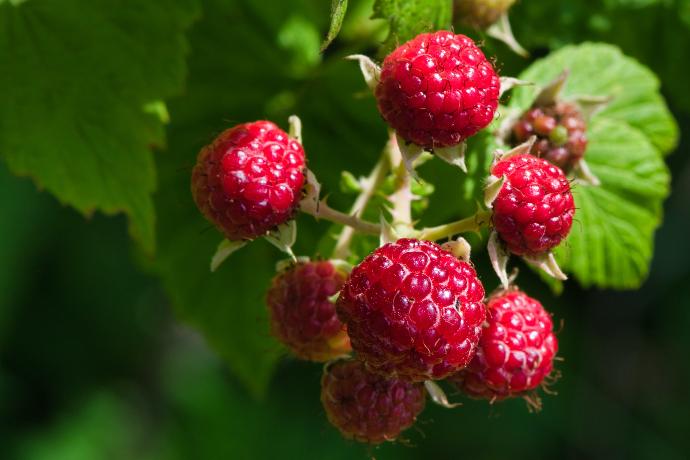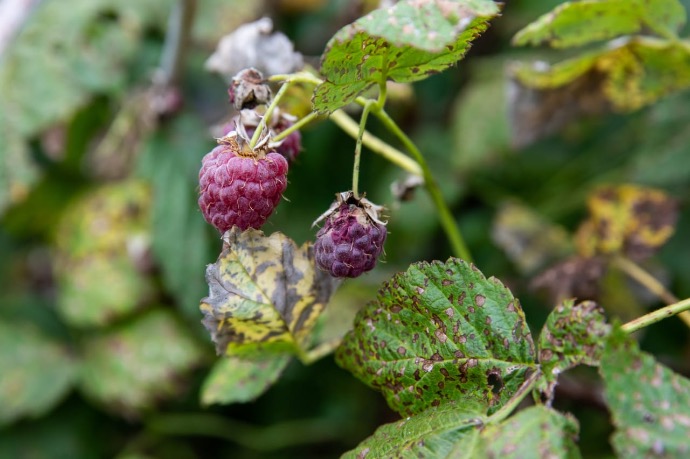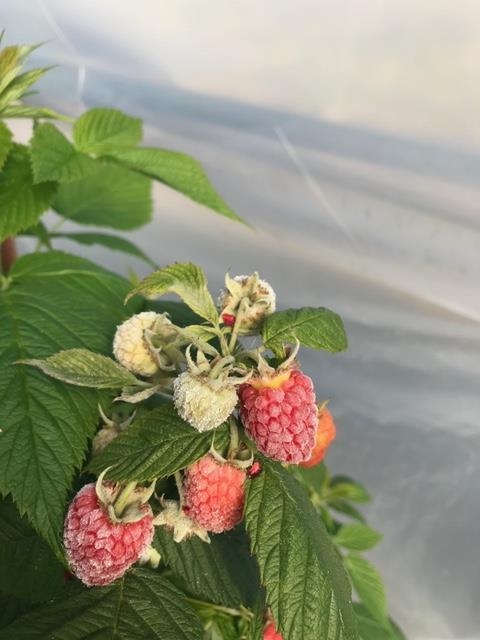Raspberry Plant
Raspberry bushes, 4-6 feet tall in Zones 4-8, excel in well-drained soil and can tolerate partial shade. Fast-growing, they produce flavorful, edible berries.

Habit
shrub
Height
1.0 to 2.0 m
Growth
fast
Soil
Well-drained, Sandy Loam
Shade
Full Sun to Partial Shade
Moisture
Moderate
Edible
Yes
Medicinal
Yes
Origin
Europe, Asia
Climatic Condition
Temperate, Subtropical
Temperature (°)
15°C to 25°C
Humidity (%)
50% to 60%
Potting media
50% Loam, 40% Sand, 10% Organic Matter
Fertilizers
Organic Fertilizer
Watering
Regular watering
Plant Weight
0.5 to 2.0 kg
Flowering Time
Summer to Fall
Soil Ph level
6.0 to 7.0
Water Ph level
6.0 to 7.0
Soil EC
0.6 to 1.0 mS/cm
Yield Per Plant
2 to 3 kg per plant
NPK ratio
10:10:10
life Span
5 to 10 years
Health Benefits
High in Vitamin C, Antioxidant
Suggested Grow Media or Potting Mix ?
50% loam, 25% compost, 25% sand
Suggested Fertigation/Fertilizers
Fertilize every 6 weeks with a balanced fertilizer.
Common Diseases and Remedies
botrytis fruit rot , powdery mildew
dark red, purple or chocolate brown spots below the spur , on young bark around buds of new shoots , cane have silvery grey appearance in the winter.
remove dead or diseased canes , prune each winter or spring to maintain narrow rows.
HEALTH BENEFITS
· Rich in antioxidants, vitamins C and E.
· Supports heart health and digestion.
What Is An Raspberry Tree?
Raspberries are perennial plants with stems that can last for two years each. Canes are spiny or smooth, and most do not bear fruit until the second year. The reed usually reaches 1.8 meters (6 feet) in height and has leaves with three or more leaflets, depending on the species or variety. The underside of the leaf is white to gray and usually hairy. The white to pink flowers have five petals and produce juicy red, purple or black (rarely orange, amber or yellowish). Unlike blackberries, the root of this fruit remains on the plant when picked. Although they are often called "berries," these berries are technically a collection of drupes (small drupes) that all contain the same seed.

What Are The Different Types Of Raspberry Plants?
1. Polana Red:- Early has large round fruits with medium/good flavour. It is resistant to zone. Strong growth. It ripens in mid-June and produces large numbers of berries. There is also a second set of small fruits in autumn.
2. Polka Dot :- Early large, hard, frozen-like fruit with rich taste. Hardy zone , Upright growth habit and strong cane spread. General line is recommended.
3. Caroline Red:- Early to mid-season Large fruits with rich flavour. It is hardy to zone . It is resistant to heat or drought. Phytophthora is less susceptible to root rot than its parents 'Heritage' and 'Autumn Fortune'.
4. Joan J Red:- Early Spring Fruits are large and hard, contain little water, which ensures long life. Hardy to zone 4, there's more heat than anything else. The pressure comes out. The first harvest can be done twice, the next harvest can be done in mid-summer and autumn.
5.Himbo Top Red:- Early to mid-season Large fruit with good flavour. It is hardy to zone. It is not heat resistant. It is very good for phytophthora root rot. Mulching during planting will help reduce the spread of disease. Since the resulting side branches are very long and the branches are very high, a good trellising system is needed.

How to care for Raspberry Plants ?
Raspberries need adequate water to maintain their lush green leaves and swelling of their berries, so keep them well hydrated during the dry season, especially during flowering and fruiting periods. It is best for groundwater - a stream or drain is ideal.
1. Location
Technically, raspberries can be grown indoors where pollinators are present. However, due to their size, hibernation period, and need for at least 6 to 8 hours of sunlight per day, they are almost always grown outdoors.
2. Sunshine
Raspberry plants thrive in a growing area that receives full sun and has well-drained, fertile soil. Full sun means at least 6 to 8 hours of sunlight during the growing season.
3. Soils
Raspberries like full sun and grow best in well-drained, sandy loam soil rich in organic matter. Remember low-lying areas that are still wet in late spring, but choose areas with water.
4. Hydration
Adequate moisture is needed throughout the growing season to obtain a good raspberry yield. However, the most important period in terms of humidity is the time from flowering to harvest. During fruit formation, raspberries need 1 to 1.5 inches of water (from rain or water) per week.

5. Nourishment
When it comes to raspberry fertilizer, you need to provide a complete fertilization containing macro and micro nutrients, taking into account the cation ratios Ca/K, Ca/Mg, (Mg+K)/Ca. Balanced NH4/NO3 Ratio - Most of the nitrogen should be nitrated and potassium-free, dechlorinated water should be used.
6. Issues
Raspberry disease
Botrytis fruit rot.
Botrytis cinerea of sugarcane (Botrytis cinerea)
Fusarium wilt of sugarcane.
Spur blight.
Powdery mildew.
rotten rotten.
Fire blight.
Disease blight.
What are the Benefits of Raspberry Plants ?
Red raspberries contain powerful antioxidants such as vitamin C, quercetin and gallic acid; It can prevent cancer, heart disease and heart disease, and prevent aging. They are rich in ellagic acid, a known chemopreventive agent, and have been shown to have anti-inflammatory properties.

FAQs About Growing Raspberry Plants
1. How to care for raspberry plants?
Raspberries need to have enough water to maintain their lush leaves and swell their berries; Therefore, maintain adequate water during the dry season, especially during flowering and fruiting. It is best for groundwater - a stream or drain is ideal.
2. What are raspberry plants used for?
This flower is used as eye cream or stomach medicine. Its roots are crushed and used as an astringent or made into a tea to treat dysentery. Some roots are chewed and used as cough syrup. Raspberry tea is used to reduce uterine contractions during labor.
3. Can I grow raspberry plants at home?
Technically, raspberries can be grown indoors where pollinators are present. However, due to their size, hibernation period, and need for at least 6 to 8 hours of sunlight per day, they are almost always grown outdoors.
4. What is the best pot to grow raspberry plants in?
Growing Raspberries in Pots . Choose a large container with a diameter of at least 60 cm. Fill the container with well-drained potting mix.
5.From where can I shop for raspberry plant?
From any certified agency or nursary


